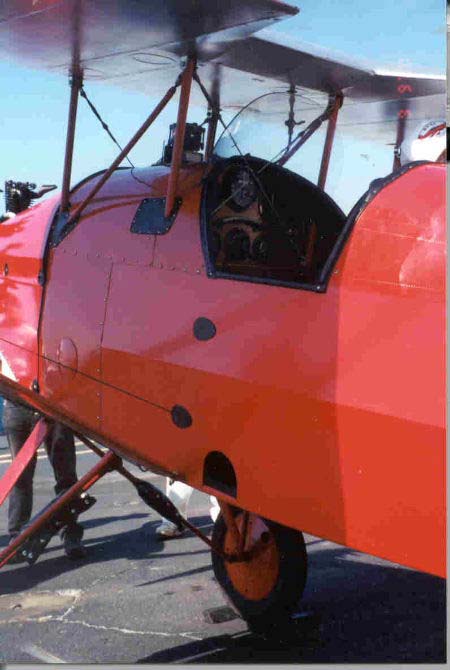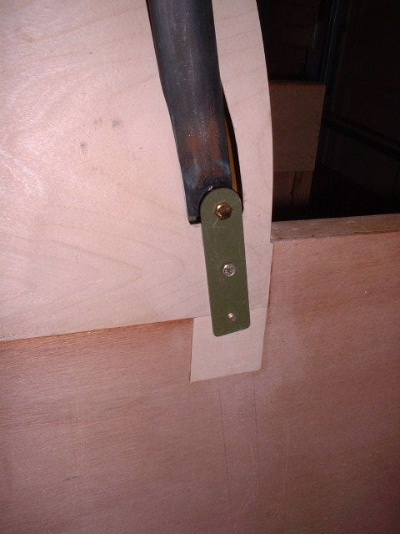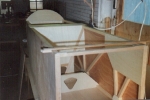CHRIS AND FRAN BARLEY'S FUSELAGE NOTES
(First published in AJ's Airborne reproduced with kind
permission)
The majority of these notes were originally supplied to Jim Wills (probably
circa 1996), following his request in the Squadron Newsletter for comments
on the plans. We then subsequently supplied them to Tony Anderson. Unfortunately
circumstances have meant that they haven't been widely seen, although
some earlier hand written notes of ours have been circulating around
some builders. We have always been very keen to pass on our experiences
to other builders to help them, just as we were given fantastic help
in the early days.
1. Drawing No 9 - Firewall Strut The front strut immediately behind
the firewall contains some detail 11 3/4" down from the top longeron.
The purpose of this detail is unclear. (I have discussed it with Jim
Wills by phone and Jim advised it should be ignored, as it was associated
with engine types other than the Continental series - ie Ford A or Corvair).
2. Drawing No 9 - Large Gussets Large gussets (21 1/2" x 5 3/4") are
shown at the front, upper inboard faces of the fuselage sides. These
seem to be particularly related to the Ford 'A' version "tray" and it
is not clear whether they should be included on the Continental/other
powered versions. Jim Wills advised by phone that they are not strictly
required for Continental versions, but we decided to include them anyway,
as do most other builders. They will help reinforce this area for fuel
tank mounting if you decide to use a fuselage tank.
3. Drawing No 1 - Rear Seat Back The rear seat back is shown on the
drawing as a 21 3/4" wide x 21" deep rectangle. Since it forms a vital
jig when aligning the 2 fuselage halves we accurately pre-made ours
to the dimensions shown and then used it to jig up and locate the sides.
Unfortunately because the seat back is inclined within the fuselage
the bottom edge needs to be slightly wider than the top edge, i.e. the
bottom edge sits in a wider part of the fuselage than the top edge.
If the seat back is pre-made as a proper rectangle it will not fit properly.
(NB the references to bottom and top edges are true edges. Since the
fuselage is assembled upside down on the building table, the true bottom
edge of the seat back is actually uppermost!).
4. Drawings 1 & 3 & 47-003 - Ash Cross Member Drawings 1 & 47-003 call
up ash cross members which are 2" x 3/4" in cross section. Drawing 3
calls up for a forward beam which is 2" x 1" in cross section with its
ends tapered to 2" x 3/4". We followed the drawing 1 & 47-003 requirement.
5. Drawings 1 & 9 - Tailplane Mounting Drawing 1 gives a dimension
of 18" between the end of the turtledeck and the end of the tailpost.
Drawing 9 quotes 18 7/8". Since the tailplane chord is 18" we have made
ours approx. 18 1/8" to allow a small clearance between the tailplane
leading edge and the rear face of the turtledeck.
6. Drawing 1 - Fuselage Width Drawing 1 quotes 24" for the fuselage
width, with the note that "all dimensions to outside of ply". However
47-004 sheets 1&2 imply that the fuselage is actually 24 1/4" wide across
the skins. Ours has been made 24 1/4" wide, but we know of others which
are 24". It probably doesn't matter much since the pick up points on
the engine mounting are very flexible and can easily accommodate a ¼"
difference. However, there is also a need to consider where the centres
of the centre-section cabane strut brackets sit in relation to the fuselage
longerons. With the centre-section brackets positioned as per drawing
and the cabane strut centralised within it, a fuselage width of 241/4"
allows a comfortable fit at the bottom end of the strut with the strut
slightly favouring the outside of the pair of fuselage brackets. Plenty
of space is then available for the outboard fillet of braze between
bolt bush and cabane strut. With a fuselage width of 24" you may need
to offset the cabane strut slightly in the centre-section brackets to
get enough space for a good sized fillet at the bottom end. Not a problem,
but something it's nice to be aware of.
7. Drawing 1 & 9 - Tail Thickness After Assembly No dimension is quoted
for the thickness of the tail-post after joining the two fuselage sides
together. Since the main beams of the tail components are all 1" thick
at this point, logically it should be the same, but it is not dimensioned.
We made ours 1" thick. If you vary the tail surface main beams (as some
builders have done - we haven't), bear this in mind.
8. Drawing 1, 4 & 9 - Bellcrank Position Various dimensions are quoted
for the position of the bellcrank above the bottom longeron lower surface
ply. Drawing 4 quotes 9", drawing 9 quotes 7 1/8" and drawing 1 quotes
7". We are using the largest dimension to try and avoid the control
cable to the upper elevator horn rubbing on the tailplane leading edge,
as many do. Pietenpol G-BKVO cunningly uses an eye and rod arrangement
to prevent this though, as on Tiger Moths.
9. Drawing 1, 4 & 9 - Bellcrank Mounting Consideration needs to be
given to sanding the vertical strut surfaces flat where the bellcrank
mounts. Since this would weaken the strut, we glued 3" x 1" x 1/4" ply
plates at the mounting faces, before sanding. These ended up with a
1/8" x 1/4" wedge shape after sanding. We used a 3 foot piece of 6"
wide Contiboard shelving with abrasive paper stuck to one face and a
2"x2" batten stuck to the other forming a stiffener and handle, as a
sanding block.
10. Drawing 1 & 9 - Seat Back Mounting As per item 9 above, the vertical
strut faces where the rear seat back mounts need to be sanded flat with
one another before trying to glue in the seatback. We set our fuselage
sides to the correct plan-form before offering up the seat back (see
item 11). The need for some sanding was immediately obvious. We used
the same sanding block as in item 9.
11. Drawing 1 & 47-003 - Floor Ply Thickness Drawing 1 quotes a floor
ply thickness of 7/32". 47-003 contains a sectional note giving the
floor ply thickness as 1/4".
12. Seat Belt Attachments This is the most worrying of all the areas
of uncertainty within the drawings. I discussed this issue in about
1994 with Francis Donaldson and he advised me to follow the advice contained
in a back edition of Popular Flying ( Jan 1990 edition, page 28). This
ultimately says that all systems must be approved by PFA Engineering.
We've basically used this information and copied some of the arrangements
used in G-BUCO. The only area that isn't yet sorted out is the difficult
one ie the front seat upper restraint attachment point. An earlier edition
of Aircamper 'Appenings and the letter from PFA containing Hal Danby's
system will be a great help when it comes to finalise the arrangements.
Unfortunately our fuselage was completely finished early in 1996 and
we've recently discovered that our aileron cables coincide more or less
with the position where the bottom cross tube of the Hal Danby designed
harness frame will go. Hal didn't have this problem (discussed at Sywell
2000), but we're going to have to work out a way around it on our aeroplane.
13. Fuselage Side Planform To hold the fuselage sides in their correct
plan positions we used blocks fixed to the building table to locate
the true top longeron (fuselage being assembled upside down) and lengths
of threaded rod to locate the true bottom longerons. At each point we
used two lengths of threaded rod passing through wooden blocks to sandwich
the longerons. A bonus was that it allowed the longerons to be eased
apart to provide clearance for gluing and then closed up again a controlled
amount. This avoided all the glue being wiped off and retained the accurate
dimension. See photo and sketch for detail. Bottom Block Longerons Rod
Nut Strut Top Longerons Block Table
14. General - Cutting Of Diagonal Braces The fuselage drawings 1 &
9 tend to indicate that diagonal braces may be cut to a point, whereas
other references we have seen insist that they be cut to a double tip.
Hopefully the sketches clarify, we've assumed both are acceptable though
since it's the ply gusset provides the load path. Most of ours are double
tipped though.
15. Centre Cabane Strut Fitting Dimensions Drawing 5 shows the aerofoil
section and shows that the spars are on 28 3/4" centres (27 11/16" +
(1 1/8)/2 + 1/2"). Referring to drawing 9, if the rearmost cabane strut
fitting is positioned over the 3" x 3/4" doubler clearly labelled as
being for this purpose, the centreline of spruce fuselage strut no 3
is actually going to be 28 3/4 " + 5/8" away. Therefore the two cabane
struts will be closer together at the top than at the bottom. Whilst
this probably doesn't matter, it does seem odd. A further concern at
this same point is that the brackets securing the main cabane struts
to the fuselage do not line up with the struts themselves. Therefore
there will tend to be a turning moment on the brackets which appears
undesirable, but most flying Pietenpols seem to have this feature and
manage quite happily.
16. Drawings 1 & 9 - Rearmost Side Gusset No horizontal dimensions
are given for the rear gusset which glues to the top longeron, bottom
longeron and tailpost. We made ours 4.5 inches wide at the top and 7.5
inches wide at the bottom. This applies on the port side fuselage frame
only. On the starboard side the whole of the last bay has a narrow plywood
frame with a rebated lip to allow an inspection panel to be fitted.
17. Tailwheel Spring Mounting It is beneficial to incorporate an ash
wedge into the apex formed by the lower longerons at the rear of the
fuselage if a conventional leaf spring mounted tailwheel is to be used
(as opposed to the drawn A-frame and coil spring type). We also added
1/8 inch ply on the bottom of the whole rear bay and on the top surface
of the ash wedge. We were conscious of the need to minimise weight at
the tail end and only did the minimum reinforcement considered necessary.
18. Rear Bay Dimensions The drawing showing the lengthened fuselage
gives no width information This has to be obtained from the original
fuselage drawing instead. We chose to keep the bay widths the same ie
on the lengthened 1966 fuselage, the first vertical strut forward of
the tail post, where the width of 5.5 inches occurs, is 19 inches from
the tailpost rather than 16.5 inches. The knock on of this though is
that the standard tailplane brace wire fitting on the underside of the
fuselage is not the correct dimensions as it now fits on a narrower
fuselage width. Others have simply kept the bay widths at various stations
the same as for the original fuselage. We don't think it matters either
way, but it's worth being aware of this point. On the underside of the
fuselage immediately forward of the rear bay the original fuselage drawing
shows an extra crossmember. We haven't incorporated it, thinking that
it is only associated with the A frame tailwheel mount. If you are using
a leaf spring tailwheel assembly it is neater to coincide the spring's
attachment point with the brace wire attach bracket. A single bolt can
secure both, and if it passes through the ash wedge mentioned in item
17 a good solid attachment results, with no weakening of the fuselage
caused by having 2 holes close together. It does mean that the brace
fitting is further aft than drawing, but this is unlikely to be a problem
since it tends towards the upper brace wire arrangement, where the brace
wires meet at the top rear edge of the fin.
19. Fuselage Frame Nodes On our aircraft, all the spruce member nodes
in the cockpit area of the fuselage side frames are filled with spruce
wedges, not just the ones where the undercarriage mounts.
20. Control Column to Bellcrank Cables We have fitted a twin pulley
assembly at the bottom edge of the rear seat, aft face to guide the
cables through the change of angle that exists here. A very small depression
(1/8" deep) was sanded in the seat cross strut at this point to allow
the cables to sit higher up than would otherwise have been the case.
This prevents the cables rubbing against the top of the control column
torque tube rear bearing housing and keeps the cables in firmer contact
with the pulleys mounted at the rear of the torque tube. Greater cable
tension would have achieved the same result but gave an unpleasant over-centre
feel to the elevator control and felt to be overloading components unecessarily.
21. Coaming Reinforcement When making the coamings from 1/16 inch ply,
it is worthwhile adding a 1/16 doubler to reinforce the lip that projects
rearwards from the plane of the instrument panel. This avoids any damage
occurring through knocks when getting in and out of the cockpits. I
can confirm that you will hurt yourself rather than damage the aircraft
(my elbow is still tender 2 weeks after thumping it into such a reinforced
edge).
22. Cockpit Area Skining If you use an 8ft X 4ft sheet of ply cut
through the middle for the two sides, it would be best to check that
it will be deep enough. It may be necessary to ensure that the skin
stops at the bottom longeron lower surface and lap the floor piece over
it, rather than overlap the other way. This is because the ply panel
may not be quite deep enough otherwise (you will need it to be 24 inches
deep, and a 48 inch wide panel cut in half will be slightly too shallow).
Using scarfed GL1 ply panels cut in half shouldn't be a problem as they
are typically 50 inches wide (just under 25 inches when cut in half).
23. General Areas Where Lack Of Information Exists · Bear in mind the
need to consider fuselage water drainage requirements. You need to anticipate
where water may gather and provide drain holes. Particularly tricky
areas are the lower tailpost areas and where the turtledeck meets the
top fuselage surface. We've put drain holes in all our lower fuselage
side frame gussets and in front of all cross.members in skinned bottom
fuselage areas. · Access panel requirements are important considerations.
We embodied a rear fuselage side panel below the tailplane (see item
16 above) and panels below the bellcrank assembly, similar to G-BUCO.
· Advice is needed by novice builders on the required grain direction
for ply panels. This appears on the supplement drawings but isn't on
the older drawings. It's not always that obvious and a mixture is seen
on the flying examples. · When fitting in a large fuselage fuel tank
it will be necessary to design in extra structure to take the new loads.
We elected to retain the original model A type tray and vertical wall
(in 1/4" ply) on which to sit our intended tank. The large front internal
gussets were also retained for this purpose to help spread the loads
into the fuselage frames.
|



